
Recalling a Legend
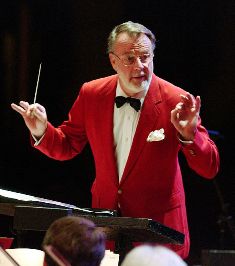
Erich Kunzel conducting the Cincinnati Pops Orchestra
|
“I will never leave Cincinnati. I’m too proud of what we have done here."
(Erich Kunzel, interview in The Cincinnati Post, Jan. 30, 1988)
Just thinking about the career of Cincinnati Pops conductor Erich Kunzel is exhausting.
He died in a hospital near his home on Swan’s Island, Maine. Brunnhilde, his wife of 43 years (44 on September 5) was at his side.
John Morris Russell, associate conductor of the Cincinnati Symphony and Pops from 1995 to 2006, now music director of the Windsor Symphony Orchestra in Ontario, Canada, recalls a telling episode:
"It was one of those typical semi-annual Sundays after a Pops weekend of rehearsals, performances and 6-8 hours of recording. At the end of the concert, Erich goes bounding into his office as the rest of the folks staggered off stage looking as if they had been put through a meat grinder.
“Those were incredibly hard working weeks for for the musicians staff and crew. Everyone was completely beat. As the musicians filed by, I caught the eye of (first violinist) Connie Kiradjieff, who was stomping off stage with a bit of a scowl.
" He pulled me aside and barked 'God bless Erich Kunzel.' I was taken completely by surprise. 'What? Are you kidding me? He just marched you through hell and back.'
Connie said, 'As much work as he puts us through, he heaps ten times as much work on himself, so I say , 'God bless him.'"
"Erich Kunzel had a tremendous work ethic and flair for the dramatic," Russell continued. "He also engaged the community from the ground up. It was not about selling tickets, it was about building relationships with the community. How many thousands of ordinary folks from across Greater Cincinnati have performed with the Pops and Erich? Kids in a gospel choir or old-timers square dancing -- every one of those community-based performers carried the experience with them for a lifetime. 'The more butts onstage, the more in the audience,' he said."
(Kunzel invited an audience of volunteers to sing along with “On Top of Old Smokey” for the Pops’ recording “Down on the Farm” in 1991 and asked them to wear red and green for the taping of its 1995 holiday special for PBS.)
Russell, an innovator himself who co-created, hosted and conducted the CSO's popular "Home for the Holidays” concerts at the Taft Theater (now discontinued) and “Classical Roots, Spiritual Heights” concerts in African-American churches, is the first to admit his debt to Kunzel.
“I have stolen several pages out of the ‘Kunzel Play Book’ while building our Pops and community programming with the Windsor Symphony Orchestra. We’ve featured our local French and Italian choirs, great Canadian sing-alongs, hip-hop dancing to Smetana, Ukrainian dancers, gymnasts, boxers, local jazz virtuosos and flag-drops and fireworks to ‘O Canada.’”
Sound familiar? And with Windsor and metro Detroit at the epicenter of the worldwide economic crisis, Russell’s concerts with the Windsor Symphony regularly play to sold-out houses, he said.
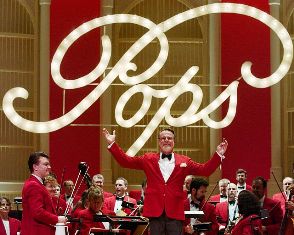
onstage at Music Hall in Cincinnati
|
Kunzel was one of the first to embrace new recording technologies. In collaboration with start-up Telarc in Cleveland, he led the Pops in a digital recording of Tchaikovsky’s “1812 Overture” in 1979 that became a mega-hit and helped propel the fortunes of the fledgling company. Telarc and the Pops made some of the first CDs and surround-sound recordings. Kunzel amassed a total of 84 with Telarc. The vast majority topped the Billboard magazine charts.
Though classical artists have always performed popular music, Kunzel and the Pops virtually created the “classical crossover” genre. Kunzel was named Classical Crossover Recording Artist of the Year by Billboard four years in a row (1988-91) and was awarded Sony’s Tiffany Walkman Award “for visionary recording activities” in 1989.
In its September 2 obituary, the New York Times described Kunzel as “irreverent.” Perhaps this helps explain why he was repeatedly snubbed for a Grammy award, even in the classical-crossover category. He won only once, for Copland: Music of America, in 1998. The French conferred their Grand Prix du Disque on him early on, for “American Jubilee” in 1989.
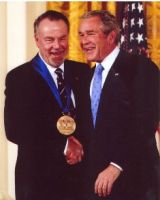
President George W. Bush awarding Kunzel the National Medal of the Arts
|
Kunzel mined Hollywood film scores for Pops concerts and CDs, bringing renewed attention to important composers like Miklos Rosza and Erich Wolfgang Korngold. As for Disney and “Star Wars” (John Williams), he and Telarc were always there with the latest hits. An admitted perfectionist, Kunzel put as much effort into songs from “Sesame Street” as orchestral works by Tchaikovsky or jazz classics by Duke Ellington.
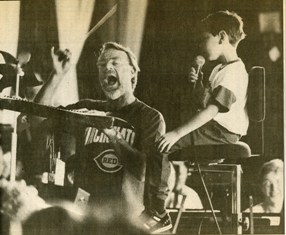
Kunzel with Michael Fishman at Riverbend June, 1989 (photo by Robert Dickerson of The Cincinnati Post)
|
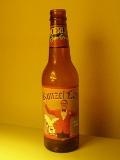
Kunzel Lager
|
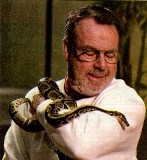
Erich Kunzel with friend
|
He put the Pops on television, with four holiday-themed shows for PBS, beginning with a Christmas Eve special in 1995 with Mel Torme.
Kunzel pushed the envelope -- or tried to -- when conducting CSO classical concerts, as he did for anniversaries and special occasions. When he wanted to add color effects to Saint-Saens’ Symphony No. 3 ("Organ" Symphony) in 1990, he was turned down. He backed the CSO’s experiment with video screens at a live CSO concert in 1992 (the images were of former CSO music director Jesus Lopez-Cobs, not Kunzel). But when an audience survey at intermission came up 50-50 for and against the idea, the CSO dropped it.
Kunzel had this to say in an interview with the Cincinnati Post in 1995:
“Obviously, there are going to be people who object to it and people who are for it, but you don’t just drop it. You work on it. You perfect it, do things with it. We’re too conservative. We’re dealing with a 200-year-old art form that has not changed, and yet no one dare to do anything about it.” Interestingly, this is no longer a radical idea and orchestras, including the Detroit Symphony, are now using video screens to enhance live performances.
Kunzel was a born showman. He began the Pops' famous "Chiller" concert in 1988 by rising from from the Music Hall pit in a devil costume. He once made his entrance at Riverbend on horseback, and he cuddled a piglet on the cover of “Down on the Farm.” He loved to banter with guests, spouted fractured German, made ad lib remarks and cast witty asides at the audience.
Kunzel easily recruited stars to perform on Pops concerts and CDs, including Torme, Katherine Hepburn, Eileen Farrell, Sherrill Milnes, Frederica von Stade, Doc Severinsen, Dave Brubeck, Cab Calloway and Rosemary Clooney (who began her career in Cincinnati). His good looks, innate charm and Ivy League background undoubtedly helped.
Rigorously trained in classical music, he graduated from Dartmouth College and did post-graduate work at Harvard and Brown Universities (he even brushed Yale one year when he served as music director of the New Haven Symphony Orchestra).
He studied conducting with the great French maestro Pierre Monteux and served as his personal assistant for two years.
Kunzel was a musicologist, scholar, pianist and talented arranger, searching library archives for original scores and source materials for Pops concerts and recordings. One of his finds was "Blue Monday," an early one-act opera by George Gershwin.
And yet he was a man of the people, conducting an annual series of free, late-summer Concerts in the Park in Cincinnati neighborhoods for 39 years. Not only did he enjoy the contact with his fans, but the concerts drew people who might not come to Music Hall or Riverbend, he said.
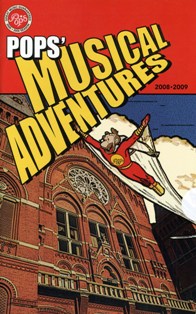
"Mr. Pops" adorning Cincinnati Pops brochure
|
His devotion to education was manifest in his allegiance to Cincinnati’s public School for Creative and Performing Arts, whose students he featured regularly on Pops concerts. In 1995 he founded the Greater Cincinnati Arts and Education Center, a non-profit fund-raising group to spearhead the construction of a new SCPA. The glittering five-story brick and stainless steel edifice, now nearing completion between Central Parkway and Washington Park in Over-the-Rhine, promises to be a lynchpin for revitalization of the area around historic Music Hall.
He took the Pops to China in 2007 to perform for the Olympic Games and regularly conducted the National Memorial Day and July Fourth concerts with the National Symphony Orchestra in Washington D.C. He set all-time attendance records at the Blossom and Ravinia Music Festivals and drew the largest crowd ever to attend an orchestra concert at Riverbend, 14,787, on July 4, 1987.
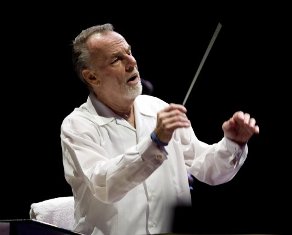
Kunzel conducting his final concert, an all-Rodgers and Hammerstein program with the Cincinnati Pops, August 1, 2009 (photo by Christopher Pinelo)
|
His colleagues and fans throughout the world can see him now, joining the heavenly vanguard.
Note: The CSO has announced that services for Erich Kunzel will be private at a gathering for family and friends in Maine. The Cincinnati Pops will announce a special memorial concert for him in Cincinnati at a later date.
A memorial book will be on display outside of Music Hall on Elm Street between 10 a.m. and 5 p.m. September 3 and 4 for the public to sign.